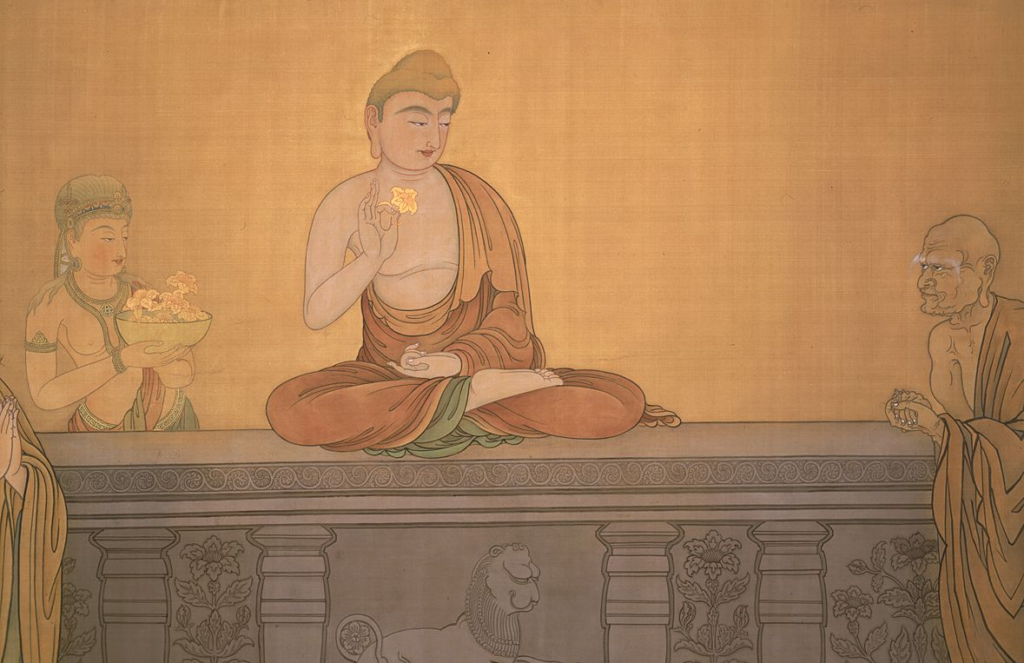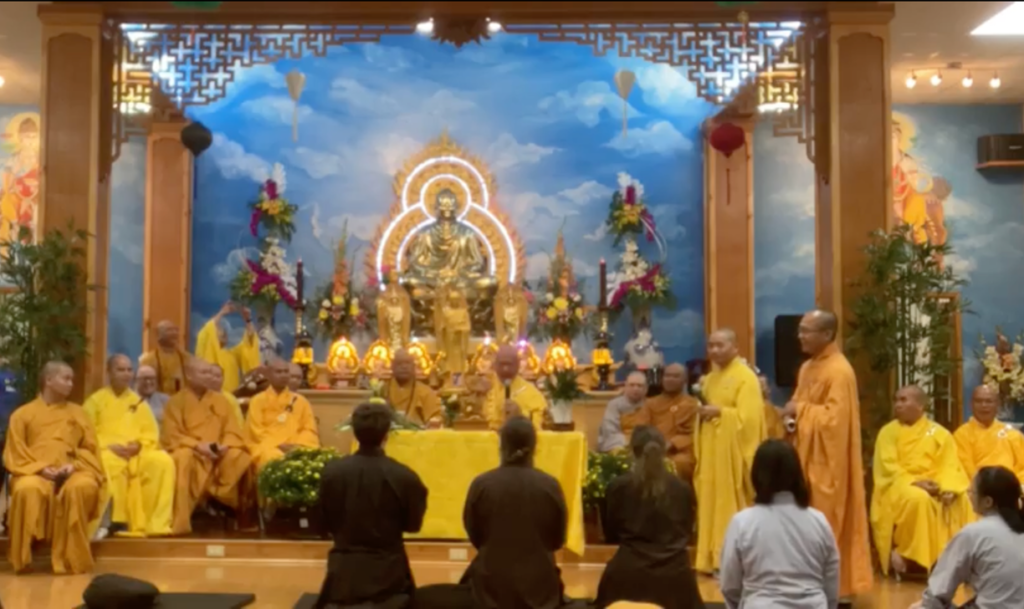Honoring ancestors is a wonderful practice and an important part of our tradition. We recognize that our existence depends on the lives of others, and we are a continuation of those lives. We depend on so many others, including: atomically, for all the elements that make up the cosmos; genetically, for our biological ancestors; physically, for our caregivers; socially, for our community network; and spiritually, for our teachers. And our lives become the bridge for those who come after us. By honoring our ancestors, we also train ourselves to be diligent in caring about the world we create now and leave for our descendants, both biological and spiritual.

NOURISHING THE ROOTS
Many of us have a complicated relationship with our ancestors. Hopefully, we have gratitude for some wonderful gifts we have inherited from them. But we have also inherited painful and, too often, harmful karmic patterns that live in and across generations. Our gratitude is mixed with suffering.
Buddhist practice helps transform these relationships and memories, both where there is joy and where there is pain. We can bow in gratitude for the opportunity to be part of that healing, to be a place where those karmic formations can be resolved and transformed. We make room for both aspects: celebrating the wondrous gifts that support the skillful aspiration to cultivate wisdom and compassion, inclining to Awakening; and healing the wounds, opening a way for us to move forward with greater peace, joy, and meaning.
So, we bow to our ancestors, both biological and spiritual, honoring them with simple gifts of incense, candles, flowers, fruit, and tea. These simple acts reconnect us with the aspiration and a deep motivation to practice. We realize that we could not exist without them, and we gratefully vow to make this life a place where all that is skillful, wholesome, and wise can thrive, and all that is unskillful, unwholesome, and harmful can heal. Our temple shrines are an embodiment of this aspiration.
The Ancestor’s Shrine

In the west of the shrine hall is the Ancestor’s Shrine, featuring photographs of deceased members and loved ones of our local temple community. At death, a memorial is held every week for seven weeks, with further memorials at regular intervals, such as 100 days and the one-year anniversary of death. Rituals are also offered during holidays.
This is an expression of our interdependence: we understand that we are the continuation of our ancestors. We have all inherited and learned from our parents and ancestors, with some qualities and habits leading to wellbeing, and others leading to suffering. Understanding this, we aspire to practice out of gratitude for this life in which we have heard the Buddha’s teachings, and for the healing of ourselves and all our ancestors.
The Teacher’s Shrine

In the east of the shrine hall is the Teacher’s Shrine, which features the photos of teachers in our temple’s lineage who have passed away. Honoring teachers is an essential part of Buddhist practice, remembering that they have made the Dharma available to us and committing to practice skillfully in gratitude for this gift.

Our teachers and community are a continuation of this generosity, dedicated to cultivating a place in southwest Missouri where we can:
• hear the Dharma,
• build community devoted to practicing the Buddha’s teachings, and
• learn to embody compassion and wisdom.
As Venerable Thay teaches us, “With the desire for Buddhism to become brighter and more widespread, we aspire to build a place dedicated to cultivating and nurturing the spiritual life, forming a temple in the hearts of each one of us.“ This wonderful aspiration arises out of our history and is embodied in the temples that share this lineage.
Zen‘s Arrival in Vietnam

Zen marks its beginning with the “Flower Sermon,” when, instead of saying a single word, the Buddha simply held a flower up for all to see. Insight blossomed in Mahākāśyapa, and he smiled. The Buddha recognized the smile as the direct transmission of the Dharma, a direct experience that cannot be contained in words. From this beginning, the practice of Zen has been handed down from master to master, across geographies, times, cultures, and languages. Over time, many branches have grown from this strong beginning. For example, Bodhidharma introduced the practice to China in the 5th century, where it became known as Chan and flourished. During the Tang dynasty, five houses were established, the Guiyang, Linji (Lâm Tế), Caodong, Yunmen, and Fayan schools. These became the basis for almost all Zen lineages today.
Chan practice spread from China to Vietnam and became known as Thiền. Traditional accounts mark the arrival of Vinītaruci in 580 CE as especially important. This Indian monk was the disciple of Sengcan, the third Chan Patriarch. Thiền practice continued to thrive and grow through the centuries. This eventually led to the formation of the Lâm Tế (Ling or Linji School) during the 17th century, when Zen Master Nguyen Thieu was sent to China to invite monastics and bring Buddhist scriptures and Dharma objects back to Vietnam. One of the monastics that received this invitation was Minh Hai Phap Bao.
Our Lineage Master

Image by Nhật Nguyệt, shared under the CCA-Share Alike 4.0 International license.
Zen master Minh Hai Phap Bao (Great Master Dac Tri) is our lineage master and played an important role in the history of Vietnamese Buddhism. Born in 1670, he was of the 34th generation of the Lam Te sect in China and is recognized as the founder of the Lam Te Chuc Thanh sect. This included the establishment of the oldest Buddhist temple in Hoi An, Chuc Thanh temple.
Master Minh Hai Phap Bao began by diligently practicing at a simple hermitage in Hoi An. Over time, both his skillful practice and teaching became well known, with more and more practitioners coming to listen to him share the Dharma. When the time was right, he began to officially receive students and ordain practitioners into the monastic sangha. He faithfully practiced the Dharma in this way for nearly fify years, until he was 77 years old. At his death, he offered his disciples a blessing in verse:
Pháp giới như mây nổi
Chân như không tánh tướng
Nếu hiểu được như vậy
Chúng sanh với Phật đồng
(The dharma world is like floating clouds;
Suchness has no nature.
If you understand this,
Living beings are with Buddha.)
The Midwest Sangha

We acknowledge this lineage with great gratitude and celebrate how the practice has developed and flourished, despite many difficult circumstances along the way. Today, Dinh Quang Temple is a member of the Midwest Sangha of Vietnamese Buddhist Temples that share this lineage, with communities in twelve states from Texas to Michigan.

Our abbot, the Ven. Thich Thong Chanh, is of the 43rd generation of the Lâm Tế (Linji) lineage of Vietnamese Thiền.
All of this comes to us as a beautiful reminder of why it is important to nourish our roots, honoring both our biological and spiritual ancestors. May the cultivation of this practice lead to the end of every kind of suffering!
Namo A Di Da Phat
